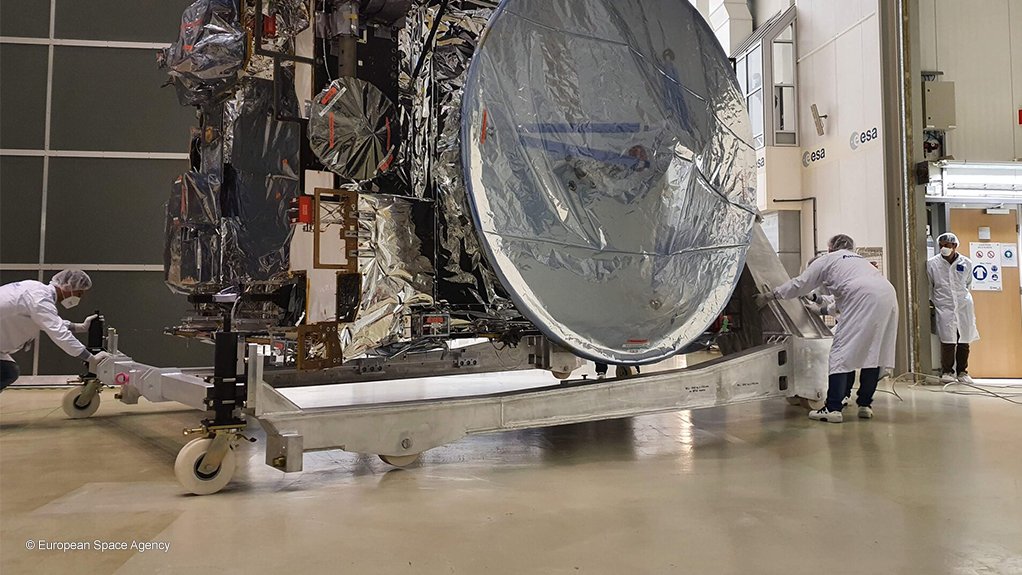Europe’s biggest deep-space mission, to Jupiter, is now launch-ready
The European Space Agency (ESA) and Airbus Defence and Space have announced that ESA’s JUICE (JUpiter ICy moons Explorer) space probe has completed assembly, integration and all tests, and is now ready for launch. The spacecraft, whose mission is focused on Jupiter’s planet-sized icy moons of Callisto, Europa and Ganymede, as well as on Jupiter itself, is now expected to be transported from its current location at Airbus’ main space facility in Toulouse, France, to the Kourou Spaceport in Guiana in South America, early next month.
“This is the biggest deep-space mission we’ve ever launched, and it needs to nimbly orbit the moons of the largest planet in the Solar System using no less than 35 flybys,” highlighted ESA JUICE flight operations director Andrea Accomazzo. “JUICE’s exploration of Jupiter and its moons will require us to perform a decade of operations we’ve never done before, and a lot could go wrong. In these [coming] weeks of simulations, we’ll have every possible problem thrown at us, so that we can handle any situation in space.”
“With JUICE’s departure for the launch site fast approaching, we remember its long Earthly journey through various Airbus sites in Europe towards final integration and more than 500 Airbus employees who prepared the spacecraft for its eight-year cruise,” observed Airbus Defence and Space JUICE project manager Cyril Cavel. “It has been an incredible adventure, along with more than 80 companies across Europe, to bring ESA’s vision to life and ultimately study Jupiter and its icy moons in-depth.”
Callisto, Europa and Ganymede are all believed to possess, beneath their icy crusts, huge oceans, each of which would contain much more water than Earth’s oceans. And where there is water, there could be life. The 6.2-t-mass spacecraft will also deeply monitor Jupiter’s magnetic, radiation and plasma environment and the interplay of this environment with the giant planet’s moons. To these ends, JUICE is carrying ten leading-technology instruments, including an ice-penetrating radar, an altimeter, a radio-science experiment, spectrometers, cameras and other sensors. Although ESA-led, the mission also benefits from contributions for the US National Aeronautics and Space Administration, the Japan Aerospace Exploration Agency, and the Israeli Space Agency.
JUICE is expected to be launched from Kourou onboard an Ariane 5 rocket in April (this will be the last ESA launch using the Ariane 5, before it is replaced by the Ariane 6). It will follow a complex course to reach Jupiter, using three flybys of Earth and one of Venus, to fling itself out to the gas giant. Its voyage to the Solar System’s biggest planet will take eight years. Once there, its actual mission will last four years. Orbiting Jupiter, it will make 35 flybys of the three icy moons, before moving into an orbit of Ganymede. It will spend the last nine months of its mission studying that world in detail, gathering data on its evolution and current nature, on the ocean believed to be under its surface, and whether it could be habitable.
Callisto, Europa and Ganymede, plus the very volcanic Io, were all discovered by the great Italian scientist Galileo Galilei, when he first observed Jupiter through the then newly-invented telescope, in 1610. These four worlds are together referred to as the Galilean moons, in his honour. One of the very last preparations made to JUICE in Toulouse was the fitting of a plaque, in honour of Galileo, to the spacecraft. This plaque reproduces the first several pages of the astronomer’s book “Siderius Nuncius”, in which he announced the discovery of the four moons and, even more importantly, that they orbited Jupiter; up to that moment, it had been believed that every heavenly body orbited the Earth.
Comments
Press Office
Announcements
What's On
Subscribe to improve your user experience...
Option 1 (equivalent of R125 a month):
Receive a weekly copy of Creamer Media's Engineering News & Mining Weekly magazine
(print copy for those in South Africa and e-magazine for those outside of South Africa)
Receive daily email newsletters
Access to full search results
Access archive of magazine back copies
Access to Projects in Progress
Access to ONE Research Report of your choice in PDF format
Option 2 (equivalent of R375 a month):
All benefits from Option 1
PLUS
Access to Creamer Media's Research Channel Africa for ALL Research Reports, in PDF format, on various industrial and mining sectors
including Electricity; Water; Energy Transition; Hydrogen; Roads, Rail and Ports; Coal; Gold; Platinum; Battery Metals; etc.
Already a subscriber?
Forgotten your password?
Receive weekly copy of Creamer Media's Engineering News & Mining Weekly magazine (print copy for those in South Africa and e-magazine for those outside of South Africa)
➕
Recieve daily email newsletters
➕
Access to full search results
➕
Access archive of magazine back copies
➕
Access to Projects in Progress
➕
Access to ONE Research Report of your choice in PDF format
RESEARCH CHANNEL AFRICA
R4500 (equivalent of R375 a month)
SUBSCRIBEAll benefits from Option 1
➕
Access to Creamer Media's Research Channel Africa for ALL Research Reports on various industrial and mining sectors, in PDF format, including on:
Electricity
➕
Water
➕
Energy Transition
➕
Hydrogen
➕
Roads, Rail and Ports
➕
Coal
➕
Gold
➕
Platinum
➕
Battery Metals
➕
etc.
Receive all benefits from Option 1 or Option 2 delivered to numerous people at your company
➕
Multiple User names and Passwords for simultaneous log-ins
➕
Intranet integration access to all in your organisation





















